 |
Picks is a monthly sampling of Japan's art scene, offering commentary by a variety of reviewers about exhibitions at museums and galleries in recent weeks, with an emphasis on contemporary art by young artists. |
 |
 |
|
|
 |
|
| Mrs. Yuki: Footprint |
| 13 May - 12 June 2016 |
Komagome SOKO
(Tokyo) |
 |
| An art unit consisting of Rintaro Hiramine and Tomomi Okubo, Mrs. Yuki specializes in art with snakes. This time they placed a python in a concrete-like liquid and let it writhe around, creating tracks that remained when the material hardened. Since a snake is basically a linear object devoid of appendages, the patterns were remarkably beautiful, evocative of wind ripples in sand or water. |
|
|
 |
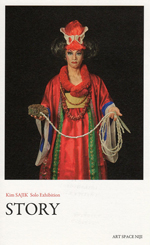 |
|
| Sajik Kim: Story |
| 3 - 15 May 2016 |
Art Space Niji
(Tokyo) |
 |
| Through page after page of meticulously wrought images, Kim weaves her own "imaginary creation myth." Breaking down boundaries between life and death, human and animal, animal and plant, human and god, male and female, she creates a stirring mashup of East Asian mythology, folklore, ritual, dress, and all manner of symbolic objects and events. The multilayered imagery seems to have emerged straight from the artist's own dreams and fantasies. |
|
|

|
 |
 |
|
 |
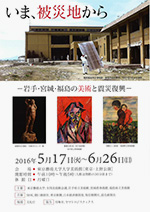 |
 |
| The Present Areas Affected by the Catastrophe: The Art of Iwate, Miyagi and Fukushima |
| 17 May - 26 June 2016 |
The University Art Museum, Tokyo University of the Arts
(Tokyo) |
 |
| The first part of this exhibition introduces modern and contemporary art from the Tohoku region; recent work by Fumiaki Aono utilizing human figures is particularly intriguing. The second part offers a documentary about the rescue of artworks from museums in earthquake- and tsunami-stricken areas, as well as a display of the restored works. The before-and-after comparison is a powerful testament to just how arduous a process restoration is. |
|
|
|
|
|
|
|

|
 |
 |
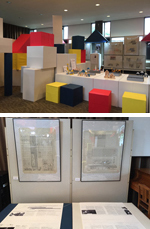 |
 |
| Takefumi Aida |
| 23 - 29 May 2016 |
Architect's House
(Tokyo) |
 |
| A retrospective of the now-venerable architect and theorist (b. 1937), best known perhaps for his Aida Blocks. The exhibit space itself is composed of large block elements, featuring a set of Aida Blocks as well as his "toy block" houses of the seventies and eighties, a design survey of urban building facades in Shibuya, Tokyo, and materials from Aida's workshops. All the displays manifest the strength and vitality of his staunchly independent stance against the grain of contemporary architectural trends. |
|
|
 |
 |
| Artists in the Age of Mechanical Reproduction - From Picasso to Warhol |
| 23 April - 5 June 2016 |
Yokohama Museum of Art
(Kanagawa) |
 |
| This reexamination of 20th-century art through the prism of mechanical reproduction technology focuses on responses by artists of the age to the "crisis in art" engendered by the development of photography, xerography, and so on. The show brings together works from the museum as well as the considerable Fuji Xerox Print Collection. Highlights include "Xerox art" of the seventies, handmade artist books, and the works of Max Ernst and Robert Motherwell. |
|

|
 |
 |
 |
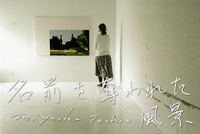
|
|
| Toshio Miyaoka: The Scenery Which Lost the Name |
| 10 - 15 May 2016 |
Kunst Arzt
(Kyoto) |
 |
| Miyaoka's landscapes appear anonymous and unremarkable, but the procedure he employs to produce them is complex. He starts with images obtained from magazine photos or the Internet, turns them around 180 degrees, then recreates them in highly abstract fashion with oil on canvas. Exaggerated white margins frame the picture plane as a rectangular cutout, underscoring the reality that a painting is nothing more than a two-dimensional image. |
|
|
 |
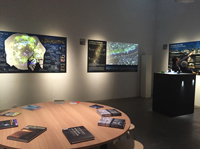 |
 |
| Nightscape 2050: A Dialogue between Cities-Light-People in the Future |
| 14 May - 10 June 2016 |
Temporary Contemporary
(Tokyo) |
 |
| With lighting designer Kaoru Mende at the helm, Lighting Planners Associates has taken this show on the road to Berlin, Singapore, and Hong Kong, altering and augmenting the content with each iteration. Much more than a showcase for LPA's designs, it offers triple-screen videos and workshops for kids in an ambitious reconsideration of the lighting environment of the world's cities. This valedictory Tokyo presentation introduced ideas for illuminating subterranean spaces, convenience stores, disaster-prevention facilities, and the Sumida River. |
|
|
|
|
|
|
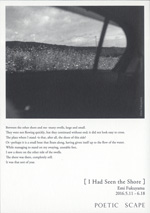 |
 |
Emi Fukuyama: I Had Seen the Shore |
11 May - 18 June 2016 |
Poetic Scape
(Tokyo) |
 |
| Snapping the shutter of her 6x7 format camera when the mood strikes, Fukuyama often shoots past foreground objects like fences or corners of buildings, which appear out of focus as she aims at a point beyond. The effect is to foreground the significance of the picture-taking process itself. Other images appear to have been shot from a moving car or train, or while walking, suggesting a concern with the viewpoint of someone perpetually in transit. |
|
 |
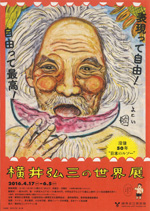 |
 |
| The World of Kozo Yokoi |
| 17 April - 5 June 2016 |
Nerima Art Museum
(Tokyo) |
 |
| Yokoi (1889-1965) enjoyed a speedy ascent in Japan's early 20th century art milieu, taking the Chogyu Prize for promising artists with his first entry in the Nikaten exhibition, then garnering the Nika Prize the following year. Though the prizewinning works do not remain, they earned him the monicker "Japan's Henri Rousseau." Later Yokoi severed ties with the Nikaten establishment and founded an avant-garde art group, but after World War II he moved back to his native Nagano and worked in solitude for the rest of his life. Like Rousseau's, his paintings are primitive, colorful and humorous. |
|
|
|
|
 |
|